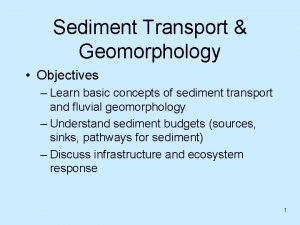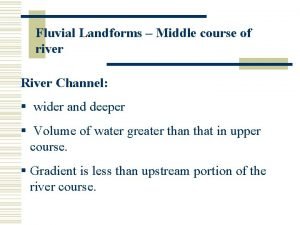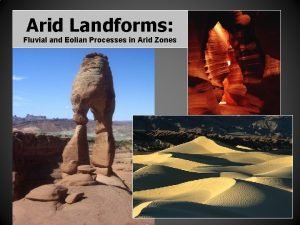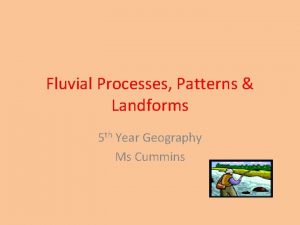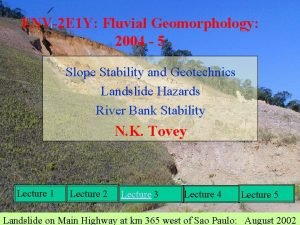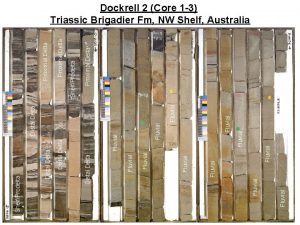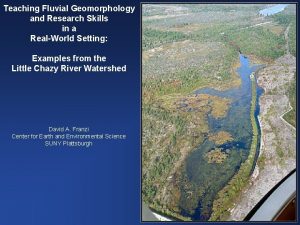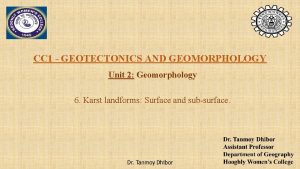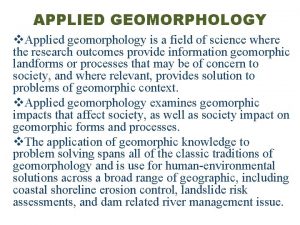ENV2 E 1 Y Fluvial Geomorphology 2004 5



























- Slides: 27

ENV-2 E 1 Y: Fluvial Geomorphology: 2004 - 5 Slope Stability and Geotechnics Landslide Hazards River Bank Stability Section 4 - Shear Strength of Soils N. K. Tovey Н. К. Тови М. А. , д-р технических наук Landslide on Main Highway at km 365 west of Sao Paulo: August 2002

ENV-2 E 1 Y: Fluvial Geomorphology: 2004 - 5 • Introduction • Seepage and Water Flow through Soils • Consolidation of Soils • • Shear Strength ~ 1 lecture Slope Stability ~ 4 lectures River Bank Stability ~ 2 lectures Special Topics – – Decompaction of consolidated Quaternary deposits Landslide Warning Systems Slope Classification Microfabric of Sediments

Section 4 - Shear Strength of Soils • Definitions: • a normal load or force is one which acts parallel to the normal (i. e. at right angles) to the surface of an object • a shear load or force is one which acts along the plane of the surface of an object • the stress acting on a body (either normal or shear) is the appropriate load or force divided by the area over which it acts. • Stress and Force must NOT be confused

Section 4 - Shear Strength of Soils EQUILIBRIUM • There are three conditions: – the net effect of all forces parallel to one direction must be zero – the net effect of all forces orthogonal (at right angles) to the above direction must be zero – the sum of the moments of the forces must be zero • the first two conditions can be checked by resolving forces (e. g. see Fig. 4. 1)

Section 4 - Shear Strength of Soils • Resolution of Forces P 1 At Equilibrium: Resolve forces parallel to P 1 : P 1 = P 2 cos 2 + P 3 cos 3. . . 4. 1 3 2 P 3 Similarly at right angles to P 1 P 2 sin 2 = P 3 sin 3. . . 4. 2

Section 4 - Shear Strength of Soils Coulomb: a French Military Engineer Problem: Why do Military Fortifications Fail?

Section 4 - Shear Strength of Soils Coulomb: a French Military Engineer Problem: Why do Military Fortifications Fail? Is there a relationship between F and N? N F F F = N tan . . . 4. 3 is the angle of internal friction N

Section 4 - Shear Strength of Soils Suppose there is some “glue” between block and surface Initially - block will not fail until bond is broken N F Block will fail F F = C + N tan C is the cohesion . . . 4. 4 Block is stable C N

Section 4 - Shear Strength of Soils F = C + N tan . . . 4. 4 above equation is specified in forces In terms of stress: = c + tan • Three types of material – granular (frictional) materials - i. e. c = 0 • = tan – cohesive materials - i. e. = 0 (wet clays) • = c – materials with both cohesion and friction • = c + tan (sands)

Section 4 - Shear Strength of Soils • Stress Point at B - stable F • Stress Point at A F F A - stable only if cohesion is present G G • if failure line changes, then failure may occur. B N

Section 4 - Shear Strength of Soils N N N N F F F dense loose N Displacement Peak in dense test is reached at around 1 - 3% strain

Section 4 - Shear Strength of Soils Increasing normal stress / dense loose displacement Displacement Normalising curves to normal stress leads to a unique set of curves for each soil.

Section 4 - Shear Strength of Soils • Types of Shear Test – Stress controlled test – Strain controlled test (as done in practical) F Failure in stress controlled test BANG! Readings cannot be taken after peak in a stress controlled test Displacement N NN N

Section 4 - Shear Strength of Soils Dense Test Loose Test displacement V V Medium Dense displacement

Section 4 - Shear Strength of Soils Plot volume changes as Void Ratio loose Void Ratio medium Critical void ratio dense displacement • All tests eventually come to same Void Ratio

Section 4 - Shear Strength of Soils Effects of Water Pressure • = c + tan • Does not allow for water pressure. • Principal of Effective Stress • From Consolidation Total Stress = effective stress + pore water pressure • or ’ = - u • In terms of stresses involved water cannot take shear • so = c + ( - u ) tan • or = c + ’ tan • Mohr - Coulomb failure criterion • if pore water pressure = 0 then original equation applies

Section 4 - Shear Strength of Soils • Distance stress point is from failure line is a measure of stability. b m lo r h o u o -C M +ve pwp Moves point closer to failure line less stability A -ve pwp moves stress point to right Moves point further from failure line • Greater distance > greater stability Slopes near Hadleigh Essex are greater stability only stable because of -ve pwp

Section 4 - Shear Strength of Soils The Triaxial Test • Problems with Standard Shear Box • Shear zone is complex • Difficult to get undisturbed samples which are square • Difficult to do undrained or partially drained tests – sands - always will be drained – clays - may be partially drained - depends of strain rate.

Section 4 - Shear Strength of Soils The Triaxial Test Load Cell Pressure Sample in rubber membrane Porous stone

Section 4 - Shear Strength of Soils The Triaxial Test • Cell pressure can be varied to match that in ground • cylindrical samples can be obtained • sample can be sealed to prevent drainage or to allow partial drainage • can perform both undrained and drained tests

Section 4 - Shear Strength of Soils • Drained Test – allow complete dissipation of the pore water pressure. – speed of the test must allow for the permeability of the material. – for clays time is usually at least a week. – measure the volume of water extruded from or sucked into the sample in such tests. • Undrained Test – no drainage is allowed. – measure the pore water pressures during the test.

Section 4 - Shear Strength of Soils • Drained Test – response to load and volume change is similar to standard shear box. • Undrained Test – burette is replace by a pore water pressure measuring device. – Since drainage is not required, test can be rapid. – Shear stress will be lower than in drained test if positive pore water pressures develop

Section 4 - Shear Strength of Soils -ve Dense displacement +ve water pressure +ve -ve • In undrained dense tests pwp goes negative • In drained dense tests volume increases Loose displacement

Section 4 - Shear Strength of Soils • 4. 8 Failure modes in the Triaxial Test. • Loading – – its length will shorten as the strain increases some bulging towards the end. • Over consolidated samples (and dense sands), – usually a very definite failure plane as peak strength is reached. • Normally consolidated clays and loose sands, – failure zone is not visible – usually numerous micro failure zones criss-crossing the bulging region. • Undrained test – orientation of the failure zone is at 45 o to the horizontal, • Drained test – orientation will be at (45 + /2), - often not as well defined.

Section 4 - Shear Strength of Soils -ve pwp +ve pwp Water squeezed out e Water sucked in Critical State Line log • Diagram gives an insight into why some slopes appear to fail soon after they have formed, while in other cases they are initially stable, but fail much later.

Section 4 - Shear Strength of Soils 4. 9 Unifying remarks on the behaviour of soils under shear. • Drained – Some soils expand – Some soils contract – Depends on initial compaction. • Undrained – Some samples +ve pwp develop – Some samples -ve pwp develop • All samples move towards Critical State Line (CSL) • What happens if sample has OCR consistent with CSL? – sample shears with no volume change in dense test – or no pore water change in undrained test.

 Applied fluvial geomorphology
Applied fluvial geomorphology Objectives of geomorphology
Objectives of geomorphology Tectonic
Tectonic Hypothesis for geomorphology
Hypothesis for geomorphology What is geomorphology
What is geomorphology Geomorphology
Geomorphology Application of geomorphology
Application of geomorphology Applied geomorphology notes
Applied geomorphology notes Dynamic equilibrium in geomorphology
Dynamic equilibrium in geomorphology Course of river
Course of river Los biomas fluviales
Los biomas fluviales Morphological analysis of landforms
Morphological analysis of landforms Transport fluvial avantages inconvénients
Transport fluvial avantages inconvénients Alluvial vs fluvial
Alluvial vs fluvial Vale fluvial
Vale fluvial Modelado torrencial
Modelado torrencial Fluvial landforms
Fluvial landforms Maqueta de relieve chileno
Maqueta de relieve chileno Animales del rio magdalena
Animales del rio magdalena Procesos fluviotorrenciales
Procesos fluviotorrenciales Fluvial process
Fluvial process Elementos topográficos de uma bacia hidrográfica
Elementos topográficos de uma bacia hidrográfica Curs calificare marinar fluvial
Curs calificare marinar fluvial Modelado fluvial
Modelado fluvial Erosão fluvial
Erosão fluvial Geography delta
Geography delta Valencia isla fluvial
Valencia isla fluvial Ollem turismo fluvial
Ollem turismo fluvial

